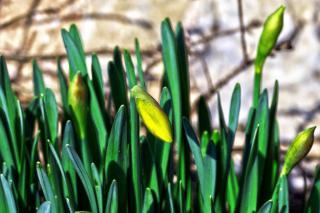

Narcissus is a beautiful bulb flower characterized by its nice yellow color. Daffodil is the common name for one of its species, N. jonquilla, a true Spring beauty!
Narcissus and Daffodil facts
Name – Narcissus
Family – Amaryllidaceae
Type – spring bulb
Height – 4 to 16 in (10 to 40 cm)
Exposure – full sun, part sun
Soil – ordinary
Flowering – from February until May
The planting and care will boost blooming, which can turn into a true event when narcissus are planted by the dozen.
Narcissus is an easy plant to please, happy in most gardens, but it’ll bloom best in richer soil.
Narcissus bulbs are ideally planted during the months of September, October and November.
Space each bulb about 2 inches (5 cm) from the next and create the clustered spots by planting 8 to 10 bulbs in this tight configuration.
Flower shops are able to offer beautiful potted narcissus over the winter.
This is out of the normal blooming cycle: for this to happen, stores trick the bulbs into thinking it’s spring. The name of this technique is forcing.
It is also possible for you to make your narcissus bloom indoors from fall until the beginning of spring.
Starting in September and until January,
Only cut the leaves when they have turned yellow through and through, because at this time, the nutrients for the following year have been gathered and stocked.
If you remove narcissus leaves just after blooming, they probably won’t bloom again in the following spring.
You can keep watering after the blooming and even add flower plant fertilizer.
Potted narcissus in pots from garden centers are “forced” to flower our houses in winter. It is difficult to keep them in their pot since they won’t bloom again unless you plant them outside.
At the end of the blooming, no need to keep your potted narcissus, because those that have bloomed indoors will bloom only once.
 Narcissus comes in many varieties, like the famous “daffodil” (“Narcissus jonquilla” which enchants our gardens early February.
Narcissus comes in many varieties, like the famous “daffodil” (“Narcissus jonquilla” which enchants our gardens early February.
Even though narcissus blooms are short-lived, about 2 weeks, you’ll appreciate its small bunches of color, while tulips haven’t yet appeared.
Flowers bloom depending on the sun. To extend the blooming, it is very easy: simply plant some of the bulbs in spots that aren’t as sunny and you’ll have flowers until the month of May.
As the legend goes, narcissus relates to ancient Greek mythology. Narcissus was a handsome young man who brutally rejected the love of a nymph whose name was Echo. Gods wanted to teach him a lesson, and they punished him by changing his heart to loving only himself – hence the word narcissist.
Every day, he would contemplate his own image in the reflection of a water fountain. One day, he even tried to kiss his own image and drowned! Gods took pity on him and turned him into a flower, the narcissus… but still, until today, he keeps miring himself in the reflection of ponds and puddles!
Once the leaves have wilted, you can cut off those ungainly dry strands, and your narcissus is ready again to bloom in the following year!
Don’t mow it down before the leaves have dried off completely, though, or they won’t flower again because they won’t have stored enough nutrients in their bulbs.
Narcissus is about the same size as grape hyacinth, and they both flower at exactly the same time. This produces beautiful spots of yellow and pastel blue flowers that are marvelous!
Tulip, hyacinth, arum, lily, iris, crocus, snowdrop, bluebell or Canna